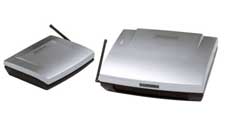 |


TechnoFILE is copyright and a registered trademark © ® of
Pandemonium Productions.
All rights reserved.
E-mail us Here!

Cutting the Umbilical Cord Behind Your HeadBy Jim Bray What’s the worst thing about surround sound speakers? That’s a matter of opinion, of course. It could be the fact that you have to mount them - or maybe hide them - or even that you have to buy them in the first place (then add center rear channels and who knows what next?). But perhaps the worst thing about surround speakers is having to string those long cables to them - and then hide them so the ankle biters or the dog don’t trip over them, or so they don’t get in the way of your décor Wouldn’t it be nice if you could cut those wires, removing any physical connection between the speakers and the amplifier that’s powering them? And why not? Everything else appears to be cutting the umbilical cord these days. Wireless is the way of the world. And wireless speakers have been around for years. I remember the first pair of wireless speakers I ever tested. They were from Koss and used infrared light to transmit the sound. This was problematic, since IR is pretty well line of sight and its performance can be hampered by the mere fact that someone had the audacity to walk between the transmitter and the speaker. And the speakers weren’t that great anyway. Then there was a pair of RCA’s I played with a few years back. These transmitted via radio frequency (RF), which made them incredibly more flexible than those IR Kosses. I put the transmitter by my home theatre and piped sound to my bedroom, living room, and back deck. It worked well, though while the speakers sounded fine for “portable music” use I wouldn’t have wanted them in my home theatre lest the rest of the system walk out in protest. Ah, but if you could do it right, wireless surround speakers might be a wonderful tool. And wouldn’t you know, some major suppliers have introduced home theatre in a box systems that incorporate wireless surround speakers. These include Kenwood and Pioneer, whose systems use RF (radio frequency) technology to eliminate the wires. Sony has chosen the infrared route. Part of the reason for the move is advances in digital wireless technology and improved amplification processes that allow for smaller size and lighter weights. Of course, if it’s just home theatre in a box customers who are going to be offered these surround speakers, it may not make a difference. After all, he said snottily, these are people who are at least as interested in convenience as they are in ultimate audio, so they may be willing to trade some performance benefit for the convenience. And it’s a heck of a convenience. How are they going to do it? Typically, different manufacturers are marching to different drums. Kenwood, who will also offer their wireless surrounds separately, is using noise reduction and “zero-bit mute circuitry” to keep the speakers quiet when they should be, and has taken the amplifiers right out of the boxes. Their digital amps are rated 50 watts each with 10 percent total harmonic distortion, and sit with their power supply in a little module that parks under your couch. The rub is that the modules use speaker cables to connect to each speaker, which kind of puts the lie to the “wireless” moniker. Still, depending on where you mount the amplifier module, the wires can be a lot shorter and less obtrusive than if they had to run all the way to the front of the room. Sony’s return to IR technology, the DAV-LF1, sends the full audio range of 20Hz-20kHz to a pair of tower speakers. Pioneer’s Home theatre in a box uses 2.4GHz RF to deliver the same frequency range. Sony says that it went digital IR instead of RF so it could avoid the static and interference that could hamper the performance of RF technology. The company claims its Digital Infrared Audio Transmission (DIAT) System transmits uncompressed digital audio and relies on redundant systems to prevent dropouts that could happen if the IR signal is blocked. I certainly hope so; those old Koss IR speakers drove me nuts with their dropouts. Sony gets the audio to the speakers by using a separate IR transmitter on each of the front left and right tower speakers. This will probably make them conversation pieces, too. Is the world ready for wireless speakers? If the manufacturers can deliver the goods, with acceptable quality and little or no premium for the wirelessness, I’m willing to bet there are a good many consumers who’d give their eye teeth not to string those darn wires that manufacturers never seem to include enough of anyway. Time, of course, will tell.
|
|
|
| Support TechnoFile via Paypal |
| TechnoFILE's
E-letter We're pleased to offer our FREE private, subscription-based private E-mail service. It's the "no brainer" way to keep informed. Our Privacy Policy |